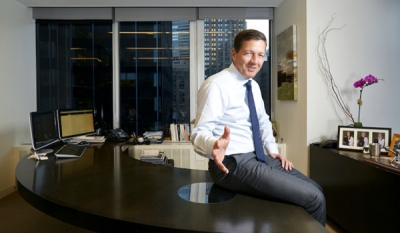Rick McVey doesn’t think of himself as a radical. He has never put forth a grandiose vision for modernizing the $7.7 trillion U.S. fixed-income business, the largest source of capital on the planet for corporations.
Rather, the 55-year-old, plainspoken Midwesterner views himself simply as a methodical problem solver.
As such, he just keeps chipping away at one of the biggest barriers to change in financial markets: Wall Street’s long-standing resistance to electronic bond trading. “I always wanted to work on Wall Street,” says McVey. “But I never imagined the magnitude of what’s happening now—that I’d have a role in changing how Wall Street actually works.”
McVey is the founder and CEO of MarketAxess Holdings MKTX -0.65% , a New York–based exchange that controls 85% of all U.S. electronic corporate fixed-income trading—a model that now accounts for about one in five customer transactions and is taking share by the day.
Over the past 15 years he’s done more than anyone else to disrupt Wall Street’s lucrative but antiquated approach to trading bonds. While equity markets have long since been dominated by electronic exchanges, the world of corporate bond trading has remained stuck in the past.
Even today, the vast majority of orders are still placed by phone and processed through investment banks, which lock in fat profits on the trades. But the system finally appears to be changing dramatically—and fast.
McVey has fomented disruption by moving in careful, incremental steps. He first won over the banks for small trades. Then, when powerful asset managers wanted a far bigger pool of buyers and sellers following the financial meltdown, McVey found them.
Now he’s launched a system in which institutions can trade directly with one another on his platform, greatly reducing transaction costs. “Rick’s genius is adapting the old system to computers, then nudging that system forward until the asset managers demanded radical change,” says Shane Finemore, founder of investment firm Manikay Partners.
It will probably take a few more years for the computer revolution to fully take hold in the bond world, but electronic trading’s momentum is so strong that it’s now poised to dominate the future.
The benefits are many: Lower costs will bring better returns for millions of small investors. Companies will issue bonds at more attractive rates and raise extra money to invest. And the corporate bond market will change from an exclusive club to a democratic place with hundreds of new participants.
McVey’s progress so far in bringing down trading costs is remarkable. Here’s how MarketAxess’s basic platform, which still accounts for most of its business, brings competition to the market and lowers markups.
An asset manager such as BlackRock BLK -1.58% will issue a “request for quote,” or RFQ, for either one security or a list of bonds. Let’s say the asset manager wants to buy $1 million in 10-year, 3.8%-yielding Walgreen bonds maturing in 2024.
Only dealers—banks and market makers—can respond to the RFQ. BlackRock sets a window of 10 minutes for dealers to respond with quotes. At the close of that deadline, all the quotes pop onto BlackRock’s screen at once. Its trader has five minutes to choose a quote, which is expressed in a “spread” over the rate on Treasuries of the same maturities.
Imagine that the dealers post 10 offers. BlackRock will then typically grab the highest spread, representing the lowest price. MarketAxess gets its revenue by adding an average of 0.2 basis point to the price of each trade, or a tiny portion of the total markup.
Today the MarketAxess spread on trades for high-grade bonds, which account for two-thirds of the market in corporates, averages 3.2 basis points. That’s half the cost of trades done the traditional way.
Hence, MarketAxess delivers about $1,000 in savings on each $1 million of bonds traded. That may not sound like much. But consider that $5 trillion in corporate bonds change hands every year.
So as electronic systems expand, the savings will be huge. “The big benefit to society will be the extra tens of billions companies can raise for investment,” says Oliver Randall, a finance professor at Emory University. “Because of electronic trading, they can issue bonds at higher prices and still pay the same interest rates.”
Shareholders of MarketAxess are already reaping rewards. The company’s sales have nearly doubled from $136 million in 2010 to an estimated $260 million for 2014.
It carries no debt and has an operating margin of 44% that puts Apple’s (a mere 29%) to shame. Since going public in 2004, MarketAxess has seen its stock jump from $11 to $64—boosting its market cap to $2.4 billion and delivering investors a 20% annualized return. For McVey, who owns about $100 million in shares and options, it’s been a very lucrative run.
It’s not certain that it will continue. New competitors are, predictably, now rushing in to challenge MarketAxess for control of what is potentially a vast market. But McVey says he remains focused primarily on the task at hand. “The big asset managers are frustrated by the old system,” says McVey. “We’re helping them take control of their own destiny.”
MarketAxess is flourishing today because of a sudden, fundamental change in the role of Wall Street. Traditionally, the big banks dominated the bond-trading business by using their own capital to buy bonds from one asset manager.
They would purchase a large block in a single transaction and assume the risk of holding those bonds on their balance sheets until they found buyers. In return, they tacked on large markups. But the web of regulations that arose from the financial crisis has changed the game.
The Basel III accord requires that banks hold far more capital as a share of their assets. That’s forced them to radically reduce their leverage and dramatically shrink their bond portfolios. At the same time, the Volcker Rule largely bars banks from taking speculative positions on bonds or other securities, virtually eliminating proprietary trading, once a major source of liquidity in bonds.
Today, because of the shrinkage in their capital, banks are performing far, far fewer of the big “one call and done” trades. What’s remarkable is that the banks have managed to remain middlemen in almost every trade, including the ones on MarketAxess.
Their role, however, has changed dramatically. They’re now acting far more like brokers than risk takers. On most trades, the banks simply match a buyer with a seller who wants the same quantity of bonds. Yet they are still charging relatively fat markups on the broker-like trades.
“They’re called ‘riskless principal’ transactions,” says Richie Prager, chief of trading and liquidity strategies at BlackRock, the world’s largest fund manager, with $4.5 trillion in assets. “The banks aren’t warehousing nearly as much risk for us anymore. Those trades are on their books for a nanosecond.”
Even as banks have been retrenching, the bond market has been enjoying a gigantic expansion. Corporations are rushing to sell new bonds while interest rates stay low. And with the Fed holding rates on Treasuries at ultralow levels, folks prize more than ever the extra couple of points offered by high-grade, and high-yield, corporate bonds.
So the U.S. is experiencing an explosion in the amount of bonds held by investors. Since 2003 the total volume of high-grade and high-yield securities outstanding has grown from $4.3 trillion to over $7.7 trillion, an increase of 79%.
Trading volume hasn’t kept pace with this expansion because investors are buying and holding bonds. But when yields eventually begin to rise—and prices fall—there will surely be a surge in trading activity.
In that scenario, the BlackRocks and Fidelities of the world fear a catastrophe. The asset managers are worried that the outmoded, phone-based system will prove too slow to handle the big jump in trades when volatility returns, leading to a liquidity crisis.
“It could potentially cause bottlenecks that would exaggerate the swings in prices,” says Prager. “The traditional system does not connect buyers and sellers in a seamless way.” The solution for BlackRock and competing managers is to connect the absolute maximum number of buyers and sellers in a giant pool. That’s where MarketAxess comes in.
McVey grew up in the suburbs of Cleveland wanting to join Wall Street, not disrupt it. His father was a fuel-oil distributor whose hobby was investing in stocks.
After receiving an MBA from Indiana University in 1983, McVey progressed from a trading position at a Cleveland bank to the raucous floor of the Chicago Mercantile Exchange. His job was to build a business for a New York firm that specialized in a new market: eurodollar futures. He learned as much about aversion to change as about futures.
“The traders at the Merc blocked electronic handsets for over 10 years,” says McVey. “They used all kinds of excuses. It was my first experience in seeing how human behavior moves slowly to embrace new technologies.”
He left in 1991 to join one of his clients, J.P. Morgan JPM -2.83% , rising four years later to become chief of U.S. fixed-income sales. Then the advent of the Internet furnished the impetus for MarketAxess.
In 1999 the bank established a program called Lab Morgan designed to back executives’ promising new ideas for using web-based technology.
McVey proposed the model that became MarketAxess. “I saw a market need,” recalls McVey. “Investors didn’t want to go to 15 different dealer sites like they did on the phone; they wanted a real central marketplace.”
At the time, a handful of firms—including Morgan Stanley MS -1.86% and Goldman Sachs GS -2.48% —virtually controlled bond trading. Banks outside the top group, such as J.P. Morgan, wanted to use electronic trading as a way to take market share from the dominant players.
That was McVey’s opening. He raised capital from ambitious challengers, such as Bear Stearns. “It was in response to the oligopoly in fixed-income trading,” says Nicolas Rohatyn, son of famed banker Felix Rohatyn and McVey’s boss at J.P. Morgan and later lead director of MarketAxess. “We were like conspirators.”
McVey launched MarketAxess in 2000 as an independent venture with two employees and $24 million in capital, operating from windowless offices provided rent-free by J.P. Morgan. By the mid-2000s, most of the original investors had sold their shares for big gains. But MarketAxess was still relatively small.
The financial crisis marked a turning point. In a prelude to what the funds fear may happen again, if on a lesser scale, liquidity vanished like a mirage in the desert.
The big banks were dumping bonds at the same time as their customers. “The asset managers told us they wanted a huge expansion in the number of dealers they could work with,” says McVey.
He courted U.S. regional and Canadian banks and firms that make markets for ETFs. Between 2008 and 2010, MarketAxess tripled the number of dealers to about 90.
The dealers who have joined since the financial crisis now handle around 35% of the trades on MarketAxess, providing far more bids and offers—and lower spreads—for the fund managers.
Today MarketAxess is a powerhouse in small to medium-size trades. It handles 30% of high-grade transactions from $100,000 to $5 million.
BlackRock, for example, does most of its U.S. electronic trades in corporates under $5 million on MarketAxess. From the start, MarketAxess appealed to dealers because they could shift the smaller, less profitable trades to an efficient, low-cost electronic platform and keep the more lucrative jumbo transactions for themselves.
Even in this quiet market, ETFs and mutual funds constantly rebalance to maintain the same proportions of bonds in different credit ratings and industries. That supplies loads of business to MarketAxess.
Still, the “block trades” of more than $5 million account for just over 50% of the market, and that’s the prize McVey is determined to reach. Why do the big funds still steer those trophy transactions to Wall Street for the old-style treatment? Many funds are highly dependent on the big underwriters, who double as the major traders, to receive allocations of hot new issues.
Typically those issues jump in price as soon as they start trading, handing the funds a nice gain. The investors reward the underwriters with lots of trading.
“The allocations are influenced by the trading relationship with the client,” says Amar Kuchinad, CEO of Electronifie, a firm that’s launching an electronic platform specializing in block trades and that will compete with MarketAxess.
Two factors are likely to shift a far bigger share of those trades to electronic platforms. The first is regulation. SEC commissioner Daniel Gallagher is outspoken in his support for measures that would promote electronic trading.
The SEC is considering rules that would standardize maturities and other features of corporate bonds, reducing the blizzard of new bonds to far fewer, larger issues that would prove a lot more liquid.
The second factor is the newest innovation from MarketAxess. Investors can now choose an option called Open Trading. “It’s the coolest thing ever,” says Prager of BlackRock. Open Trading allows investors to gather quotes from not only the approximately 100 dealers on the system, but also from 900 “buy side” investors, such as ETFs, pension funds, and sovereign wealth funds.
“That’s a great innovation, because it enables the funds to deal directly with each other,” says Mike O’Brien, director of global trading at Eaton Vance, manager of some $13 billion in fixed-income investments.
Never before in bond trading have the investment funds been the price makers. They’ve always responded to prices first proposed by the banks.
The funds will now have a far stronger incentive to mine databases to determine accurate market prices. In addition, Open Trading enables investors to move big blocks of bonds without showing their hand. If a trader wants to sell $50 million in GE bonds, it can put out an RFQ for $2 million, and once it finds a buyer, negotiate privately to sell more in, say, $3 million increments.
McVey needs to keep innovating to fend off growing competition. Starting in the late 1990s, dozens of electronic platforms entered the market, but few survived.
Two of those survivors are now looking to grab business from MarketAxess: Bloomberg, which dominates corporate bond trading in Europe but owns only a small share in the U.S.; and Tradeweb, a giant in government securities that’s making a strong push into the big-ticket institutional market.
“Their challenge will be gaining traction given MarketAxess’s deep penetration with the buy side,” says Anthony Perrotta, an analyst with the Tabb Group.
Still, McVey’s success shows that radical change can come from unexpected places, or people. Rohatyn claims to be pleasantly puzzled by his friend and protégé’s achievements.
“Rick is just an all-American guy,” he marvels. “You’d never have mistaken him for an entrepreneur, a rich banker, an innovator—and certainly not a revolutionary.” McVey may not see himself that way either, but it’s getting harder to deny it.
This story is from the December 22, 2014 issue of Fortune.
























